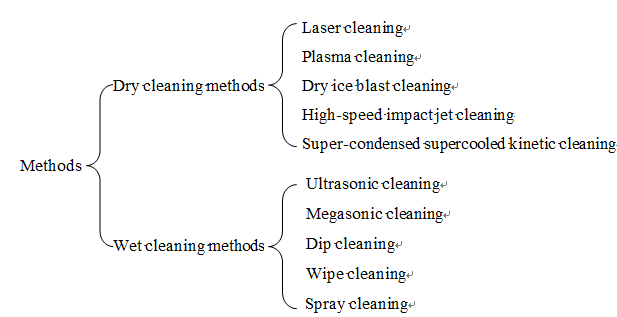
| Version | Summary | Created by | Modification | Content Size | Created at | Operation |
|---|---|---|---|---|---|---|
| 1 | Jiang Guo | + 990 word(s) | 990 | 2020-06-26 10:18:21 | | | |
| 2 | Catherine Yang | Meta information modification | 990 | 2020-07-13 07:57:48 | | | | |
| 3 | Vicky Zhou | -16 word(s) | 974 | 2020-10-29 09:26:36 | | |
Video Upload Options
It is difficult to avoid surface contaminants in the processes of integrated circuit manufacturing, optical elements processing and additive forging. The presence of surface contaminants will bring great problems to above process. For example, in large- scale integrated circuits manufacturing, the submicron contaminants on silicon wafer surface will cause defects in the chip directly [1]. And in the manufacture of optical elements, the quality of the cleaned surface will directly affect the damage resistance of optical elements [2], and the presence of surface contaminants will affect its service life [3]. Similarly, during the additive forging process, the surface contaminants will affect the interface healing state of the substrate and ultimately affect its bonding performance. However, surface contaminants can be removed effectively by a suitable surface cleaning method, so surface cleaning is of great significance to solve the above problems.
1. Introduction
Commonly used surface cleaning methods can be generally divided into dry cleaning methods and wet cleaning methods. Dry cleaning methods generally use gas as a carrier to remove contaminants by means of pressure or suction, or to remove contaminants by means of energy from external high-energy substances. Dry cleaning methods mainly include laser cleaning, plasma cleaning, dry ice blast cleaning, high-speed impact jet cleaning and super-condensed supercooled kinetic cleaning. In contrast, wet cleaning methods use water or other liquid solvents as a medium to remove impurities by soaking, spraying or vibrating. The main wet cleaning methods include ultrasonic cleaning, megasonic cleaning, dip cleaning, wipe cleaning and spray cleaning.
2. Classification of Specific Surface Cleaning Methods
3. Dry Cleaning Methods
The laser cleaning method is the most widely used dry cleaning method, which has the characteristics of high cleaning efficiency and flexible selection of the cleaning area. It achieves the cleaning function by using a laser beam to irradiate the surface to cause instantaneous thermal expansion of the pollutants and the substrate or vaporizing and evaporating the pollutants [4][5][6]. Plasma cleaning can remove contaminants with atomic-level size. It uses the "activation" and "bombing" of high-energy particles in the plasma to remove contaminants[7]. This method has a good cleaning effect, but it also has the disadvantages of low efficiency and high cost. The high-speed impact jet cleaning method is often used to clean small-sized workpieces. Its working principle is to apply a high-speed air jet to cause the particles to float twice, thereby blowing away the contaminants. Simple and reliable is the biggest feature of this method, and the pre-charge treatment of the surface which to be cleaned can greatly improve the removal efficiency. In the dry ice blast cleaning process, dry ice particles are sprayed onto the surface of the workpiece by compressed air, and surface contaminants are removed through particle impact, air purge, energy conversion and other processes [8][9][10]. The dry ice blast cleaning method has no pollution and can remove the contaminants in the cracks, but it will cause slight abrasion and corrosion on the surface during the cleaning process. The super-condensed supercooling kinetic cleaning method is to use suspended particles of argon and nitrogen to collide with pollutants. In addition to being pollution-free and easy to operate, the biggest advantage of this method is safety [11].
3. Wet cleaning methods
Ultrasonic cleaning mainly relies on the effect of ultrasonic cavitation to form cavitation bubbles on the workpiece surface, and strikes the surface continuously to remove contaminants [12][13]. It should be noted that if the cleaning fluid is a chemical solvent, the cleaning effect will be better. This method is widely used in the field of optical elements cleaning, which can flexibly control the cleaning intensity, but it has poor cleaning ability for particles whose diameter is less than 1 μm. Different from ultrasonic cleaning, megasonic cleaning uses sound waves to push the solution molecules into an accelerated motion, and impacting the surface with a high-speed fluid wave to removing surface contaminants, in addition, the cavitation effect produced by megawave also plays a role in cleaning process [14]. Compared with ultrasonic cleaning, megasonic cleaning can bring better cleaning effect and less surface damage [15]. But the cleaning tank will limit the size of the workpiece to be cleaned whether it is in ultrasonic cleaning or megasonic cleaning, therefore, the nozzle cleaning method is getting more and more attention, it makes clean large-sized workpieces by ultrasonic and megasonic cleaning become possible. The dip cleaning method will immerse the workpiece in the cleaning solution and rely on the activity of the solution to squeeze the oil away from the substrate surface [16]. This method is easy to operate and can achieve large-scale cleaning, but the decontamination ability is limited. It is often used to clean non-precision components that do not require high cleanliness. Wipe cleaning method is the most traditional cleaning method, it uses mechanical force to remove contaminants. This method is simple and efficient, but it may lead to some surface damage. The spray cleaning method using a high-pressure spray pump to spray water or cleaning liquid to the surface, and removing contaminants through the impact action and chemical action of cleaning liquid. This method is simple in process, but the chemical cleaning liquid may cause environmental pollution.
Compared with wet cleaning methods, dry cleaning methods does not need to consider the hydrophobic characteristics of the surface to be cleaned, and does not require chemical reagents and cleaning fluids, so dry cleaning is very friendly to the environment. However, the large-scale cleaning capacity of wet cleaning is also unmatched by dry cleaning. It should be pointed out that both dry cleaning and wet cleaning have their specific limitations, thus, the appropriate cleaning method should be selected according to the actual situation. In addition, different cleaning methods need to work together to achieve a better surface cleanliness with the improvement of cleaning requirements.
References
- M.Y. Si; Experimental study on laser cleaning of particle contaminants from silicon wafer surface. Dalian University of Technology 2006, Dalian, China.
- J. Neauport; L. Lamaignere; H. Bercegol; F. Pilon; J.C. Birolleau; Polishing-induced contamination of fused silica optics and laser induced damage density at 351 nm. Optics Express 2005, 13(25), 10163-10171, 10.1364/opex.13.010163.
- R. Diaz; M. Chambonneau; R. Courchinoux; P. Grua; J. Luce; J.L. Rullier; J.Y. Natoli; L. Lamaignère; Influence of longitudinal mode beating on laser-induced damage in fused silica. Optics Letters 2014, 39(3), 674-677, 10.1364/ol.39.000674.
- Y.Y. Ye; X.D. Yuan; X. Xiang; X.F. Chen; X.X. Miao; Laser cleaning of particle and grease contaminations on the surface of optics. Optik-International Journal for Light and Electron Optics 2012, 123(12), 1056-1060, 10.1016/j.ijleo.2011.07.030.
- M. Stafe; C. Negutu; I.M. Popescu; Theoretical determination of the ablation rate of metals in multiple nanosecond laser pulses irradiation regime. Applied Surface Science 2007, (253), 6353-6358, 10.1016/j.apsusc.2007.01.060.
- D. Grojo; A. Cros; P. Delaporte; M. Sentis; Experimental investigation of ablation mechanisms involved in dry laser cleaning. Applied Surface Science 2007, (253), 8309-8315, 10.1016/j.apsusc.2007.02.117.
- W.W. Yang; H.W. Du; D.W. Wang; Y.X. Xu; Research of low pressure plasma cleaning inline. Electronics Process Technology 2011, 32(01), 12-15+27, 10.14176/j.issn.1001-3474.2011.01.008.
- J.W. Chen; H. Mu; Q. Hu; Z. Jiang; Investigation on the process of dry ice cleaning insulators. IOP Conference Series: Materials Science and Engineering 2018, 394(4), 042112.
- G. Spur; E. Uhlmann; F. Elbing; Dry-ice blasting for cleaning: process, optimization and application. Wear 1999, (233), 402-411, 10.1016/s00431648(99)00204-5.
- M.M. Hills; Carbon dioxide jet spray cleaning of molecular contaminants. Journal of Vacuum Science & Technology A: Vacuum, Surfaces, and Films 1998, 13(1), 30-34, 10.1116/1.579439.
- J.L. Sheng; Analysis of development for cleaning technique on IC manufacture. Semiconductor Technology 2006, (03), 166-169, 10.13290/j.cnki.bdtjs.2006.03.002.
- B. Niemczewski; Cavitation intensity of water under practical ultrasonic cleaning conditions. Ultrasonics Sonochemistry 2014, 21(1), 354-359, 10.1016/j.ultsonch.2013.07.003.
- B. Verhaagen; T. Zanderink; D.F. Rivas; Ultrasonic cleaning of 3D printed objects and cleaning challenge devices. Applied Acoustics 2016, (103), 172-181, 10.1016/j.apacoust.2015.06.010.
- F.P. Chen; X.Y. Zhang; X. Wang; X.C. Tao; S. Yang; D.H. Wang; V. Vartanian; B. Sapp; Post TSV etch cleaning process development using SAPS megasonic technology 2015 26th Annual SEMI Advanced Semiconductor Manufacturing Conference (ASMC) 2015, 10.1109/asmc.2015.7164470.
- C.L. Chu; T.Y. Lu; Y.K. Fuh; The suitability of ultrasonic and megasonic cleaning of nanoscale patterns in ammonia hydroxide solutions for particle removal and feature damage. Semiconductor Science and Technology 2020, 35(4), 045001, 10.1088/1361-6641/ab675d.
- H.W. Kim; R. Reif; Ex situ wafer surface cleaning by HF dipping for low temperature silicon epitaxy. Thin Solid Films 1997, 305(1), 280-285, 10.1016/s0040-6090(97)00122-3.
- M. Watanabe; T. Sanada; T. Mashiko; A. Hayashida; Order estimation of physical processes in dynamics of steam-water mixed spray cleaning technique. Solid State Phenomena 2012, 187(3), 141-144, 10.4028/www.scientific.net/ssp.187.141.





